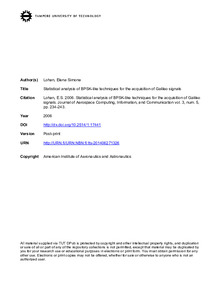Statistical analysis of BPSK-like techniques for the acquisition of Galileo signals
Lohan, E.S. (2006)
Lohan, E.S.
2006
Julkaisun pysyvä osoite on
https://urn.fi/URN:NBN:fi:tty-201406271326
https://urn.fi/URN:NBN:fi:tty-201406271326
Kuvaus
Peer reviewed
Tiivistelmä
The main modulation types selected for future Galileo signals are sine and cosine Binary-Offset-Carrier (SinBOC/CosBOC) modulations. On one hand, BOC-modulated signals have a narrower main lobe of their Autocorrelation Function (ACF), which allows a better accuracy in the delay tracking process. On the other hand, the acquisition process becomes more complex, due to the ambiguities in the ACF, which impose a large number of timing hypotheses for accurate detection of the signal. Several BPSK-like methods have been proposed in the literature so far and they are based on the idea that the BOC-modulated signal can be seen as a superposition of two BPSK-modulated signals, located at negative and positive subcarrier frequencies. If only one band (i.e., positive or negative) is used, we have a single SideBand (SB) technique. If both bands are used (and combined non-coherently) we have a dual SB technique. While removing the non-ambiguities in the ACF, both single and dual SB techniques suffer of performance degradation compared to a pure BPSK method, due to the non-coherent processing and to the deterioration of the correlation function properties after filtering or band selection. This paper proposes a comprehensive theoretical analysis of the properties of the BPSK-like techniques, based on the statistics of the detection variables, obtained from the simulations.
Kokoelmat
- TUNICRIS-julkaisut [16882]
